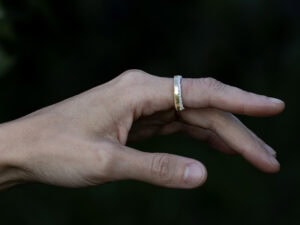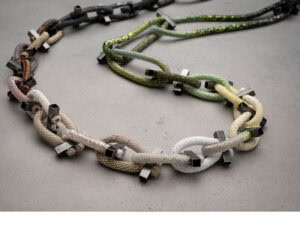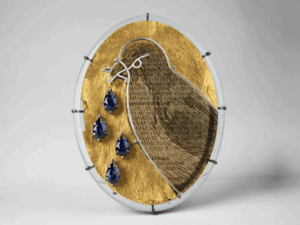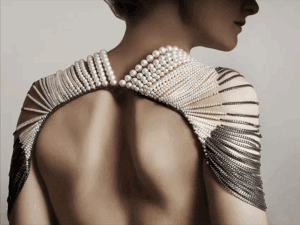Collecting jewelry through Facebook? It’s possible. An ephemeral act of collecting occurred in the social media world in April 2011, after SOFA NY in New York City. There, Sienna Gallery presented Costume Costume: An Opulent Project.
The Opulent Project is a collective working out of Portland, Oregon, that was formed in 2006 by Erin Gardner and Margaret Drinkwater. The Opulent Project acknowledges and strives to bridge the gap between art and conventional jewelry by organizing projects and producing jewelry within a conceptual framework. The jewelry produced by The Opulent Project and its contributors strives to be accessible to a broad audience and transcends mainstream preconceptions, creating discussion for both the informed and uninformed viewer.
In Portland, The Opulent Project is establishing itself as a presence that connects Portland jewelers by growing a network for art jewelry in a city that is largely devoid of one. In the past The Opulent Project has curated exhibitions under the name 18K Gold Tone, has organized Portland-based jewelers for their Gallery Reject studio event and frequently opens their studio and gallery space to the public on First Thursdays, Portland’s monthly gallery walk.
The Opulent Project sells jewelry in several museum stores and galleries and frequently makes work that considers the nature of luxury items. When Sienna Gallery asked The Opulent Project to organize a special attraction for SOFA NY, a cumulation of several projects emerged as Costume Costume. The idea behind the project was to explore costume jewelry, defined as ‘objects existing as simulations of unattainable luxury items.’
For Costume Costume at SOFA NY, The Opulent Project invited 20 emerging artists to create jewelry about costume jewelry. They were asked to investigate the nature of costume jewelry, which has a vast range of styles, qualities and designs and because costume jewelry is most often affordable, the artists were also asked to cap the price of their work at $400. The artists selected were mostly young emerging artists, who approached the subject of costume jewelry from a variety of angles. Mary Hallam Pearse, for example, played with conventional costume jewelry by obscuring the sparkles of found costume jewelry in fuzzy flocking, while Theresa Sterner recorded the crushed silhouette of costume jewelry in thin metal. The playful and sometimes ridiculous nature of costume jewelry was embodied in the work of Islay Taylor who bejeweled brass knuckles with hand painted acrylic nails.
At SOFA NY, guests were welcomed into a tiny booth the size of a walk-in jewelry box, painted Tiffany’s teal and equipped with a photo booth made from a digital camera and printer. Surrounded by jewels they could touch and wear, guests were asked to play dress-up and then ham it up for the camera.
The Opulent Project devised the use of the photo booth as a presentation device. It had been used previously as a tool to display jewelry on the body, in a casual and accessible environment, where friends could be utilized as models. The Opulent Project had experimented with using the photo booth for catalogs and website design, but at SOFA NY the photo booth took on a larger role. It offered interaction between the guest and the jewelry on display, encouraging the jewelry to be worn on the body, instead of just observed from a distance. The photo booth attracted a wide and varied audience within the context of SOFA NY. It offered something different from traditional displays that sometimes felt museum-like. The structure of the booth asked guests to directly interact with the jewelry, giving them a chance to play with the jewelry.
The guests became wearers as they tried on jewelry and posed for the camera. Some guests acted as though they were simply uncontrollable in their (faux) newfound wealth. Others took on the persona of the sophisticated elite and some even creatively repurposed the jewelry as monocles or hair ornaments.
The guests were given a printed souvenir strip of the photos taken in the booth. The digital files then made their way to the internet, Facebook specifically. The images were uploaded to Sienna Gallery’s Facebook page and were initially tagged with the wearer (when known) and the jeweler whose work the wearer was pictured with. For those who are non-Facebook users, tagging is a feature on Facebook that allows the user to label photographs by adding the name of a person (or people) pictured and/or add their location. The tag is a direct link to that person’s Facebook page. In this case, when a wearer and an artist were tagged together, it links both of their profiles to that picture – creating a direct connection. Facebook brought public opinion into the mix and provided a framework that connects the wearer to the artist, the gallery and the event. Tagging the photographs created a direct connection between the parties involved.
We were surprised and delighted when the images began to take on a life of their own, watching as the photo-booth pictures became profile pictures, were re-posted and commented on. In some cases, where the identity of the wearer was unknown, it was sometime after the images had been uploaded that the wearer found the picture and was able to tag it. As the images circulated through social media networks, the wearers were transformed into what they were presented as – the owners of the jewelry they were wearing, or, in other words, collectors. Since the social media context is far enough removed from the actual event of trying on the jewelry at SOFA NY, the photographs’ meanings are successfully reattributed and the presentation becomes part of that person’s internet persona. As the photos are tagged and saved, they are essentially collected. The wearers become collectors and the jewelry photographed becomes collected.
This has a very different character than traditional collecting. These are not treasures you’re going to find in your grandmother’s jewelry box, though many of the objects were interpretations of conventional jewelry. But it does relate to the condition of contemporary jewelry, which is seen by most people as images, not as tangible objects. The collectors of the Facebook images have become the owners of the jewelry within that context. The images offer ownership without purchase.
Social media allowed the photographs taken at SOFA NY to take on a life of their own, warping the line between wearer and collector. Without it, the images alone lose what makes them special – the direct connection to the artist and the gallery. Without that, the images are static. The nature of this act of collecting is intriguingly ephemeral because it only exists within social media. Meanwhile, the tangible jewelry that was photographed exists elsewhere. What happened with the images from SOFA NY was a delightful and inspiring surprise. The results of Costume Costume will be investigated further by The Opulent Project in future projects.




